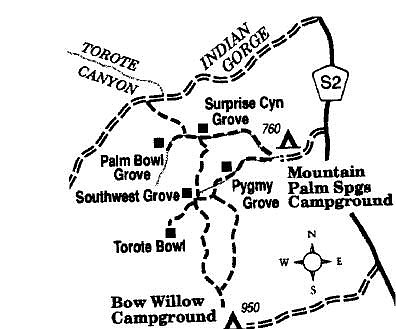 Facebook
Facebook
 X
X
 Instagram
Instagram
 TikTok
TikTok
 Youtube
Youtube
The area called Mountain Palm Springs in southern Anza-Borrego Desert State Park cannot lay claim to the largest palm oases in our local desert, but it does feature some of the most charming ones. The palms hereabouts grow in gregarious clusters or stand scattered in ones and twos and threes along the bottoms of ravines flanked by utterly desolate, rocky slopes. You can find small pools of surface water amid some of the palms; otherwise, the water is not far underground. The palms (Washingtonia filifera) enjoy sunshine on their leafy crowns and require a permanent supply of water at their roots, which penetrate only to a shallow depth.
Many of the palms here have never been burned: they still hold full skirts of dead fronds around their trunks, the better to serve the local population of rodents and snakes. In late fall and early winter, thousands of sticky, sweet palm fruits, the outer skins of which taste vaguely like dates, hang in great swaying clusters from the palm crowns. Birds gorge on this cornucopia of sugar, and coyotes quickly gobble up whatever of it falls to the ground.
The palm groves are distributed along several small washes that drain an area of about one square mile on the east side of the Tierra Blanca Mountains. Water lies close to the surface here because of ongoing (in geologic time) displacements along the Elsinore Fault. A primitive camping area sits on the alluvial fan just below the point where the washes come together. A short dirt road leads to this campground from mile 47.1 on Highway S-2.
Consider the loop hike described here as a fairly complete tour of the area: Begin by walking up the small canyon southwest of the primitive camp. Past some small seeps you'll come upon the first groups of palms -- Pygmy Grove. Some of these small but statuesque palms grow out of nothing more than piles of rock.
A pause is in order at Southwest Grove, a restful retreat shaded by a vaulted canopy of shimmering fronds. A couple of elephant trees (called torotes in Spanish) cling to the slopes just above the grove, but for a better look at these curious plants, you can climb a spur trail to Torote Bowl, where a larger group of them lies.
From Southwest Grove, pick up the well-worn but obscure trail that leads north over a rock-strewn ridge to Surprise Canyon Grove in Surprise Canyon. Up-canyon from this small grove lies Palm Bowl, filled with tangled patches of mesquite and fringed on its western edge by well over a hundred large palms.
To conclude the loop hike, return to Surprise Canyon Grove and continue down-canyon to the campground. En route, at a point nearly all the way back, you bypass diminutive North Grove, hidden in a side drainage on the left.


The area called Mountain Palm Springs in southern Anza-Borrego Desert State Park cannot lay claim to the largest palm oases in our local desert, but it does feature some of the most charming ones. The palms hereabouts grow in gregarious clusters or stand scattered in ones and twos and threes along the bottoms of ravines flanked by utterly desolate, rocky slopes. You can find small pools of surface water amid some of the palms; otherwise, the water is not far underground. The palms (Washingtonia filifera) enjoy sunshine on their leafy crowns and require a permanent supply of water at their roots, which penetrate only to a shallow depth.
Many of the palms here have never been burned: they still hold full skirts of dead fronds around their trunks, the better to serve the local population of rodents and snakes. In late fall and early winter, thousands of sticky, sweet palm fruits, the outer skins of which taste vaguely like dates, hang in great swaying clusters from the palm crowns. Birds gorge on this cornucopia of sugar, and coyotes quickly gobble up whatever of it falls to the ground.
The palm groves are distributed along several small washes that drain an area of about one square mile on the east side of the Tierra Blanca Mountains. Water lies close to the surface here because of ongoing (in geologic time) displacements along the Elsinore Fault. A primitive camping area sits on the alluvial fan just below the point where the washes come together. A short dirt road leads to this campground from mile 47.1 on Highway S-2.
Consider the loop hike described here as a fairly complete tour of the area: Begin by walking up the small canyon southwest of the primitive camp. Past some small seeps you'll come upon the first groups of palms -- Pygmy Grove. Some of these small but statuesque palms grow out of nothing more than piles of rock.
A pause is in order at Southwest Grove, a restful retreat shaded by a vaulted canopy of shimmering fronds. A couple of elephant trees (called torotes in Spanish) cling to the slopes just above the grove, but for a better look at these curious plants, you can climb a spur trail to Torote Bowl, where a larger group of them lies.
From Southwest Grove, pick up the well-worn but obscure trail that leads north over a rock-strewn ridge to Surprise Canyon Grove in Surprise Canyon. Up-canyon from this small grove lies Palm Bowl, filled with tangled patches of mesquite and fringed on its western edge by well over a hundred large palms.
To conclude the loop hike, return to Surprise Canyon Grove and continue down-canyon to the campground. En route, at a point nearly all the way back, you bypass diminutive North Grove, hidden in a side drainage on the left.
